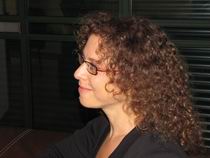|
 Noga Barkai Noga Barkai
Noga has been teaching yoga for over 20 years, and practicing yoga since 1988. She holds a BA in Hebrew Literature and Indian & Sanskrit Studies from the Hebrew University of Jerusalem. Noga teaches a varied audience ranging from beginner groups open to the general public; courses and mentorships for teachers & advanced practitioners; rehabilitative & therapeutic yoga; and workshops on yogic texts.
A student of Orit Sen Gupta and senior teacher of Vijnana Yoga, Noga is certified by Orit Sen Gupta to lead the three-year, 800-hour Vijnana Yoga Teacher Training at Wingate Institute in Israel. Drawing on her experience teaching therapeutic yoga, Noga has developed a specialized continuing education course for certified Vijnana yoga teachers in Rehabilitative Yoga from a Vijnana Yoga Perspective. This 330-hour course opened in autumn 2013 at Wingate Institute, and is taught by Noga in conjunction with Alphonse Tarshel. Born and raised in Jerusalem, Noga and her husband and two sons recently relocated to Hod HaSharon in central Israel.
My Meeting with Yoga
Towards the end of my army service, shortly before my twentieth birthday, I searched for a teacher of Tai Chi in Jerusalem. My motivation was a deep and moving meeting with sitting meditation that I had experienced at the age of twelve. My older brother Itai studied Tai Chi and Kung Fu with a teacher whose primary practice was sitting. The powerful memory of practicing meditation with my brother and his teacher, Tsvi Weissberg, had accompanied me ever since. I knew that when I would be independent -- when I would complete school and my compulsory army service -- that I would search for the place I had found within myself and would learn to abide there. Other than that, I had no idea what I was going to do with my life.
Fate would have it that my brother's teacher left Israel and returned to the U.S., and because I could not find another teacher of Tai Chi in Jerusalem, I went to yoga, following a general, murky knowledge that yoga was also a type of bodywork that involved meditation.
From the time of my first lesson while still in uniform, I have not stopped practicing yoga. With the end of my service, while working waiting tables from morning until night, yoga practice became the most meaningful thing in my life. I attended 3 or 4 lessons a week and I tried to practice at home. There was much youthful passion in my excitement over yoga, as well as great naivetÚ, and I could not understand then how meaningful yoga would be in my life.
Naturally this was also a period of confusion and vacillation -- To study at university? What to study? Perhaps to set out on a long trip to Asia? South America? In the end I found myself in New York, living in an apartment with a group of Israelis, young and confused like myself, working sticking sparkles on high-heeled designer shoes, and saving money for a long trip, still unsure of my destination.
Surya namaskar, basic pranayama, and a few asanas were my practice, and looking back I can say that this simple practice protected me during a very confused time. After five months in New York, at the last minute before the beginning of the school year, I decided to return to Israel to study. This was an intuitive, spur-of-the-moment decision, divorced from the plan I thought I had made.
I returned to Israel two days before the semester began. My luck was that I was already registered at the university -- my father had taken care of that. Now I had two days to decide what I would study. I thumbed through the course offerings of the faculty of humanities. It was clear to me that I would study literature because of my great love of the written word and stories -- a love borne during my early childhood. I checked the religion department, and the program for Indian, Iranian and Armenian studies caught my eye. I had no idea that such a program existed at the university, but without too much contemplation I signed up for the India and Sanskrit studies track. This turned out to be one of the most meaningful, influential decisions of my life -- taken without thinking, and definitely without understanding that my study of Sanskrit and Indian culture would become inseparable from my yogic path.
These were years of study and growing up. After three years studying yoga with Tsipi Negev, I met Orit Sen Gupta and since then I am her student. I have had the good luck to accompany the path called Vijnana yoga from its inception. My yoga practice became established through sustained integration with my life: I married, became pregnant, gave birth. Over the years I have experienced great joys and also sadness and loss.
Yoga does not save us -- and it is good that it does not -- from the fact that, for better or worse, we are human. But practice can create a bridge for gradual change through a sometimes painful friction with the grittiness of everyday life. The glow of yoga illuminates -- in simplicity and warmth -- every corner of human experience, if we can only succeed in seeing.
After more than twenty years of practice, I feel that I have journeyed a long way-even if the path is still long and twisting. The intuition that guided me to search for a teacher of Tai Chi in the days before my twentieth birthday was indeed right.
|